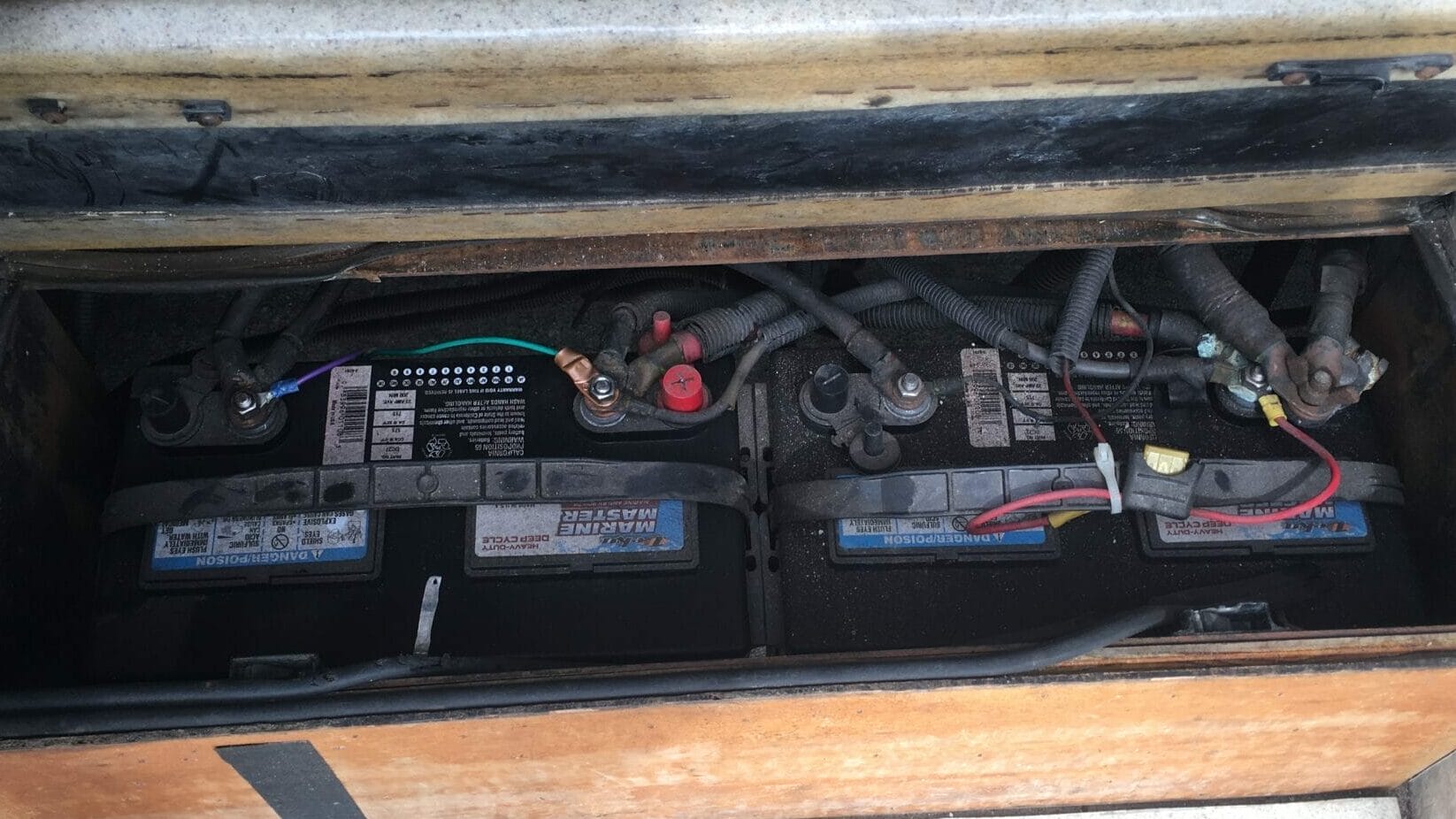This post contains affiliate links.
It’s always fun to get the RV ready for another adventure after it’s been in storage but what isn’t fun is finding out your house batteries are dead. Without your house batteries, most of the equipment in your RV won’t work properly.
Your RV batteries should be disconnected when your RV is not in use or is stored. Disconnecting the batteries will prevent them from discharging below safe levels and causing damage. Depending on how long your RV will be stored you can use the battery disconnect switch or fully disconnect the battery terminals.
Caring for your batteries when your RV is in storage will prolong the lifespan of your batteries and prevent early and expensive replacement. Learn the reasons you should disconnect your batteries as well as how to do it in this article.

Table of Contents
Should I Disconnect My RV Battery When Not in Use?
I always recommend you disconnect your camper’s batteries if your RV will be sitting unused for more than a couple of days. If your batteries are left connected while your RV is in storage something called parasitic draw can occur. Parasitic draw or drain is when electrical appliances use a small amount of battery power even when they seem to be off.
A great example of this is the internal clock in many appliances. Another common culprit to parasitic drain is your safety equipment, like your smoke detector, propane detector, or carbon monoxide detector. These all use battery power to function.
These constant trickles of power can slowly deplete the batteries. If a battery falls below 50%, then it can damage the battery and shorten its lifespan. Your deep cycle battery may not be able to recover from this.
Corrosion is another concern if the batteries are left connected. One year, over the winter, we left our batteries in our RV with the terminals connected, and the battery disconnect switch was off. Our battery terminals were extremely corroded when Beau went to get the RV ready for the season. Fortunately, he was able to clean them off but it did take some elbow grease. Check out Beau’s video on how he cleaned the terminals below. He also shows how he disconnects our batteries and uses a battery terminal connector.
One last thing to consider is safety. Now this scenario is fairly rare but does happen. Imagine you left your batteries connected but mice got into your RV. Mice love to chew things and they chew through an electrical wire. This could lead to the broken wire shorting out and damaging your electrical appliances or even starting a fire. Theoretically, this could still happen with your battery disconnected but if a short did occur when power was turned on you would at least be present.
How to Disconnect Your RV batteries
There are two ways to disconnect the batteries in your RV (the same goes for a motorhome, travel trailer, 5th wheel, etc.) One way is best for short term storage and the other is best for long term storage.
Using the Battery Disconnect Switch
When storing your RV short term, such as over a week or two, even up to a month, it’s easiest to use the battery disconnect switch. This will be a switch near your coach batteries that when it is flipped, it disconnects the batteries from all appliances and power; both incoming and outgoing.
Our switch is located in the stairwell of our motorhome next to the batteries (which are stored under the stairs). It is a 1.5-inch metal lever that makes a big “click” sound when flipped. This sound is the contactor opening and closing which will allow power to and from the batteries.
One thing to consider is if all the 12-volt power in your RV is wired through this switch. After market changes to your electrical system could bypass this switch and still cause a parasitic drain on your batteries.

Disconnecting the Battery Terminals
If your RV will be stored for several months or over the winter then it’s best to fully disconnect your batteries and even remove them from the RV. By fully disconnect I mean remove all the wires that are connected to the terminals of the battery.
To start, ensure your generator is off, disconnect from shore power, and flip the battery disconnect switch. These are good safety practices and should prevent power from coming in or out of the batteries.
First, you will disconnect the negative terminals. Unscrew the nut on the top of the terminal. Remove any wires and connectors, also called lugs, from the terminal. Once removed you should cover any exposed metal with electrical tape and also label where they are connected to so you can easily reconnect later. Covering the metal will prevent any accidental contact of the lugs with metal or other connectors and create a short. A plastic bag will also work too.
Next, you will do the same with the positive terminals. It is especially important to wrap the connectors that come from the chassis batteries. These could be live if the battery disconnect switch is on. To watch Beau disconnect our RV batteries check out his video on YouTube or scroll up and watch it here.
Since we disconnect our batteries every year, Beau installed battery terminal connectors to make connecting and disconnecting much easier. Basically, they let you connect all the wires and lugs together and then you have one easy to install piece when you connect and disconnect your battery. We bought ones like the ones below.
- DURABLE QUICK RELEASE DISCONNECT: solid brass made, which has excellent conductivity and flexibility to reduce voltage distortion and power...
- EFFICIENT BATTERY TERMINAL CONNECTOR: red & black colour-coded robust wing nut, which allows quick and easy wire replacement. Easily attach...
- NEAT DESIGN BATTERY TERMINAL: terminals are clearly colour coordinated. Red is positive and black is negative. Also with the + (positive)...
Once the wires are completely removed there can be no load on your batteries. If you live in a climate with extreme temperatures you should remove your batteries from the RV and store them inside. Really hot or really cold weather can damage your RV’s batteries. Every year Beau disconnects and removes all 4 of our batteries (both house and chasis batteries) and stores them in the basement connected to a trickle charger. The trickle charge keeps the batteries fully charged while they are stored over the winter.
Learn more about storing your RV’s battery over the winter in our article, How to Store an RV Battery for Winter.
- 【10-AMP QUICK CHARGER】12V 10-Amp and 24V 5-Amp 7-stage quick battery charger and maintainer, charging speed is much faster than 8-Amp or...
- 【 WINTER & HOLIDAY BATTERY TRICKLE CHARGER】Battery trickle charger is a low-current method of charging a battery to maintain its fully...
- 【HIGH-EFFICIENCY PULSE REPAIR EXTEND BATTERY CYCLE LIFE】battery charger automotive detects battery sulfation and acid stratification,...
What Drains RV Batteries When Not in Use
Several factors can contribute to draining RV batteries when the vehicle is not in use.
- Parasitic Loads: These are tiny, continuous electrical draws that may not be immediately obvious but together can lead to battery drain over time. Some electrical devices within the RV, such as propane detectors, clocks, radios, or alarm systems, may continue to draw small amounts of power even when the RV is not in use.
- Normal Battery Discharge: Batteries will naturally discharge over time. A battery will lose roughly 5% of its battery power every month. It’s important to store your batteries with a full charge. We usually have a trickle charger on our batteries when they are stored over the winter to prevent them from fully discharging.
- Inverter Standby: If your RV has an inverter, it might have a standby mode that consumes power even when no appliances are running. This standby mode can contribute to battery drain over time.
- Faulty Wiring or Components: Wiring issues or malfunctioning components within the electrical system can create unintended power drains. For example, a short circuit or a malfunctioning switch could cause continuous power draw.
- Climate Control Systems: If your RV has climate control systems like fans or thermostats, they may draw power intermittently, especially if they’re set on automatic settings or if there are electronic controls.
- Solar Panels (If Equipped): While solar panels primarily charge the batteries, they can also have a small reverse current flow during periods of darkness, particularly if they are not equipped with blocking diodes. This reverse flow can lead to a minor drain on the batteries.
- Faulty Batteries: If the batteries themselves are old, damaged, or faulty, they may experience self-discharge at a faster rate, leading to quicker depletion when not in use.
If your battery seems fully charged but then doesn’t stay charged for long you may have another issue. Learn more in my article why your RV battery keeps dying.
Final Thoughts
Simply using the battery disconnect switch for short term storage or fulling disconnecting the batteries when storing your RV for more than a month will help extend the life of your house batteries. Removing the batteries fully from your RV is a good idea if you live somewhere that gets really hot in summer or cold in winter.


